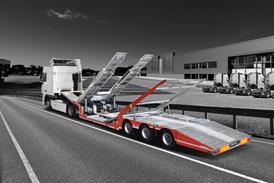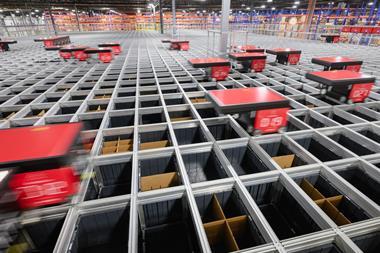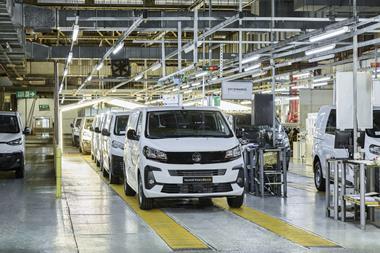Stellantis’ revenue and profits have dropped in the first half of the year, with the OEM blaming a “challenging industry context” and a product blitz underway. Meanwhile, its CEO has triggered a “strategic review” of UK business because of the zero-emission vehicle (ZEV) mandate.
In the first half of 2024, Stellantis reported net revenues of €85 billion ($92.3 billion), down 14% compared to the same time period last year. The carmaker made net profits of €5.6 billion, almost half (48%) of what was recorded in the first half of 2023, and an operating income of €8.5 billion, down €5.6 billion compared to H1 2023. The OEM’s free cash flow was also impacted, falling to near zero, because of negative working capital development and higher investment spend, although Stellantis said it expects positive free cash flow by the end of the year.

The company said the performance “fell short of expectations,” reflecting both a challenging market as well as its own operational issues. Lower volumes and mix, inventory reduction, and temporary production gaps because of a generational portfolio transition all had an impact on the results according to the financial documents, as well as a lower market share, particularly in North America.
During the financial results webcast, Carlos Tavares, CEO, Stellantis said: “It is an understatement to say that the first half results of 2024 were disappointing and humbling. It represents a perfect convergance of several headwinds in a very transitional period that opens the road for a product blitz of 20 new products. This is a bump in the road that we are now fixing and that we are going to fight against to make sure that we can rebound from here and that we fix the operational issues we have faced.”
In the financial documents, Tavares added that the 20 new vehicles launching this year bring bigger opportunities but he said the carmaker has significant work to do, especially in North America, to maximise its long-term potential.
Uncertain EV demand
Stellantis said that uncertainty in light electric and battery electric vehicles (LEV/BEV) adoption rates will be a challenge in 2024, and added that the OEM is positioning itself to “navigate a complex regulatory environment”.
Tavares said that the European market is challenging, especially with Chinese EV competition, but that it has stabilised. However, he said the OEM has “a specific problem to solve in the UK”. He said the UK is a very difficult market, adding that this is because of the zero-emission vehicle (ZEV) mandate, which is “hurting the business model significantly”. The ZEV mandate requires that 22% of cars produced by a manufacturer in the UK are electric, and that 10% of vans are electric, reaching 80% by 2030 and 100% by 2035.

“This is triggering a strategic review of the business model, including the manufacturing footprint,” Tavares said. “As we have two EV plants in the UK, and as the UK government is asking for more BEVs, we cannot be in a position where our business model is damaged by the ZEV mandate.”
He added that the strategic review has been triggered because the OEM cannot be “victim” to the mandate.
“This is something that we have been discussing with the UK government, we have been having an intensive and productive dialogue but so far we don’t have the answers we need, so we will see what comes next and I have decided to trigger a strategic review of our business model in the UK, because we cannot be making BEVs in the UK and be the victims of the ZEV mandate, this is a contradiction that the company cannot accept.”
Product blitz and localisation
This year, Stellantis has been making an effort to localise its automotive supply chain and take more control over its finished vehicle logistics, while reducing inventory ahead of new product launches.
In February, Maxime Picat, chief purchasing and supply chain officer, Stellantis told Automotive Logistics in an exclusive interview that the carmaker identified that its capacity to react was limited in outbound logistics, and as a result, the OEM has made moves to acquire direct vehicle logistics capacity. Stellantis completed the majority stake acquisition in French vehicle logistics firm 2L Logistics in April, with future plans to seek more control of its outbound logistics.
Also in April, Stellantis reduced its inventories and adjusted its production ahead of this year’s launch of new and mid-cycle product launches on the STLA platform. The carmaker consolidated shipments of 1.3m units in the first quarter of the year, reducing shipments by 10% in comparison to Q1 2023.
In the H1 2024 results, the company said ten of the planned 20 new product launches for this year have already started.
Product launches in H1
- Peugeot 3008 and 5008: Based on the BEV-native STLA medium platform. In June, nearly 30% of 3008 orders were for the BEV version. Peugeot localised production of the 2008 in South America
- New Lancia Ypsilon: Stellantis has a 10-year strategic plan to propel the brand forward.
- Maserati Grecale Folgore: Maserati’s first full-electric SUV
- Ram 1500
- Citroën Basalt: 72% of orders for the new C3 are for the B-segment EV model produced in Europe
- Stellantis Pro One Vans: includes 12 models across Citroën, Fiat Professional, Open, Peugeot and Vauxhall. Stellantis Pro One is the OEM’s number one brand in Europe, South America and Middle East & Africa in the first half of 2024.

























![Global[1]](https://d3n5uof8vony13.cloudfront.net/Pictures/web/a/d/s/global1_726550.svgz)













No comments yet